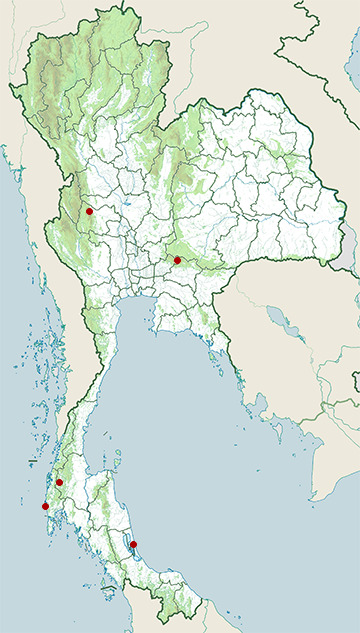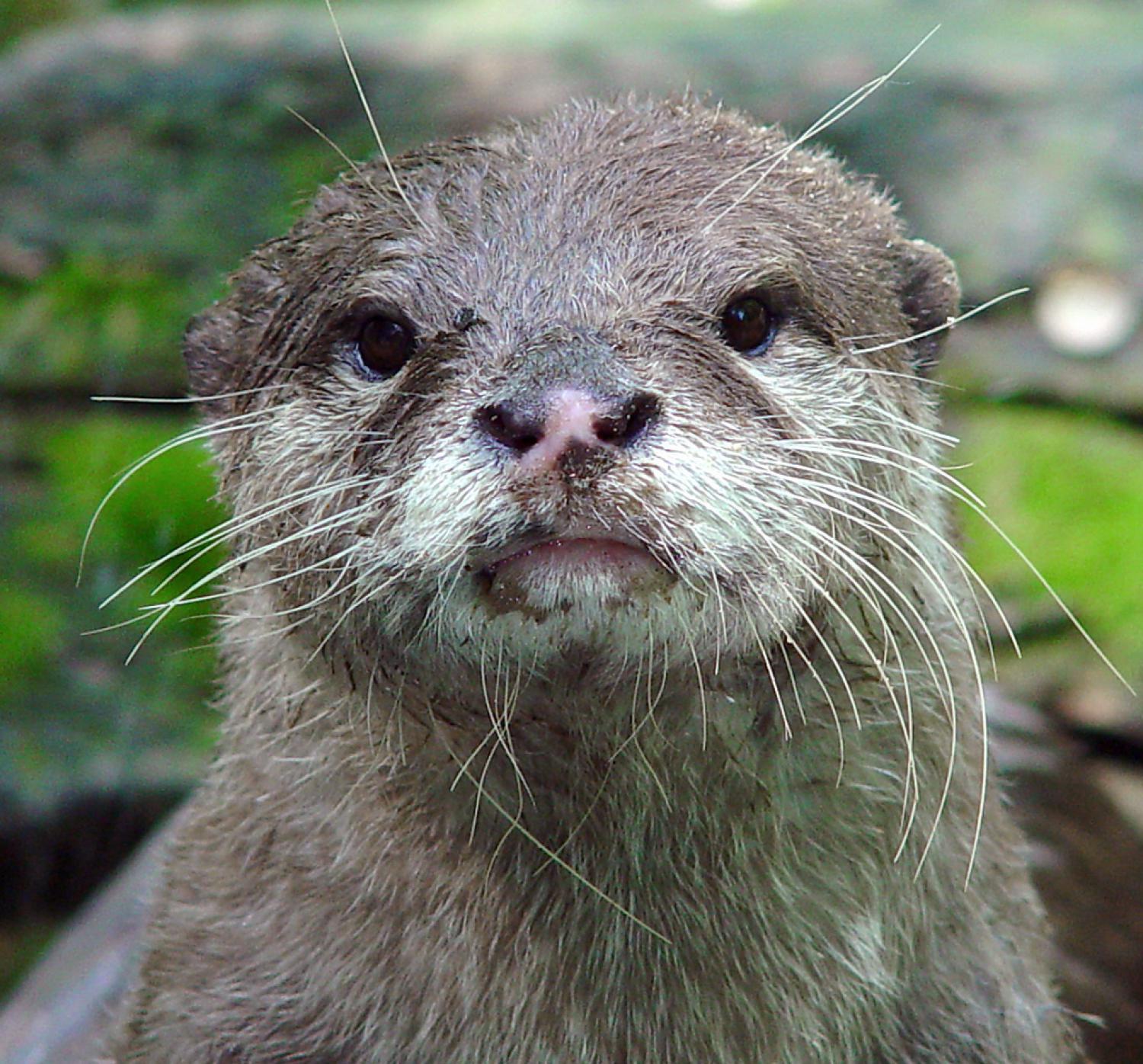Species of Thailand
Oriental small-clawed otter
Amblonyx cinerea
Johann Karl Wilhelm Illiger, 1815
In Thai: นากเล็กเล็บสั้น
The Asian small-clawed otter (Aonyx cinereus), also known as the oriental small-clawed otter or simply small-clawed otter, is a semiaquatic mammal native to South and Southeast Asia. This species is a member of the otter subfamily (Lutrinae) of the weasel family (Mustelidae), and is the smallest otter species in the world. Its paws are a distinctive feature; its claws do not extend beyond the fleshy end pads of its partially webbed fingers and toes. This gives it a high degree of manual dexterity so that it can use its paws to feed on molluscs, crabs and other small aquatic animals.
The Asian small-clawed otter inhabits mangrove swamps and freshwater wetlands in South and Southeast Asia. It lives in extended family groups with only the alpha pair breeding; offspring from previous years help to raise the young. Due to ongoing habitat loss, pollution, and hunting in some areas, it is listed as Vulnerable on the IUCN Red List.
Taxonomy
Lutra cinerea was the scientific name proposed by Johann Karl Wilhelm Illiger in 1815 for an otter collected in Batavia. In the 19th and 20th centuries, several zoological specimens were described:
- Lutra concolor proposed by Constantine Samuel Rafinesque in 1832 was a uniform coloured otter from Assam. Rafinesque also proposed Amblonyx as name of a subgenus for otters with short, obtuse claws.
- Lutra leptonyx proposed by Thomas Horsfield in 1824 were two adult small-clawed otters collected in Java. It was subordinated to the genus Aonyx by John Edward Gray in 1843.
- Amblonyx cinerea nirnai proposed by Reginald Innes Pocock in 1940 was a dark brown small-clawed otter from Virajpet in South India.
Results of a mitochondrial cytochrome B analysis published in 1998 indicated that it should be subordinated to the genus Aonyx. Results of a molecular study published in 2008 showed that the Asian small-clawed otter is a sister taxon of Lutrogale, lending support to retaining the genus Amblonyx or expanding Aonyx to make it monophyletic. They genetically diverged about 1.5 million years ago.
The Asian small-clawed otter groups with the African clawless otter and the smooth-coated otter into a sister clade to the genus Lutra. Hybridisation of Asian small-clawed otter females with smooth-coated otter males occurred in Singapore. The resulting offspring and their descendants bred back into the smooth-coated otter population, but maintained the genes of their small-clawed otter ancestors. Today, a population of at least 60 hybrid otters exist in Singapore.
Characteristics
The Asian small-clawed otter has deep brown fur with some rufous tinge on the back, but paler below. Its underfur is lighter near the base. The sides of the neck and head are brown, but its cheeks, upperlip, chin, throat and sides of the neck are whitish.
Its skull is short, and the naked rhinarium rounded above. The muzzle has long coarse vibrissae on either side. Its eyes are located toward the front of the head. The small ears are oval-shaped with an inconspicuous tragus and antitragus. Its paws are narrow with short digits that are webbed to the last joint. There are short hairs on the lower sides of the interdigital webs. The four-lobed plantar pads are longer than wide. The claws are short, almost erect, and in some individuals even absent.
Females have four mammary glands.
The Asian small-clawed otter is the smallest otter species in Asia. In head-to-body length, it ranges from 18.4 to 24 order=flip with a 10.2 to 13.6 order=flip long tail. The tapering tail is thick and muscular, especially at the base, and more than half the length of the body. Hind feet are 3.8 to 4 order=flip long. Length of skull ranges from 84 to 94 mm order=flip. It does not have upper premolars and only four postcanine teeth above.
Adult captive otters range in weight from 2.7 to 3.5 kg.
Distribution and habitat
The Asian small-clawed otter is distributed from India to Southeast Asia including the islands of Sumatra, Java, Borneo and Palawan. In southern India, it occurs along shallow mountain creeks in hill ranges up to an elevation of 2000 m in Karnataka, Nilgiri and Palni hills in Tamil Nadu. Farther north, it occurs in coastal regions of Odisha, and in wetlands in West Bengal, Assam and Arunachal Pradesh. It inhabits freshwater wetlands such as swamps, meandering rivers, irrigated rice fields as well as estuaries, coastal lagoons and tidal pools.
In western Java, it inhabits areas along slow-flowing irrigation channels, pond areas and rice fields surrounded by vegetation that offers shelter. It also occurs in mangroves.
It has also been introduced to the United Kingdom.
Behaviour and ecology
The Asian small-clawed otter is mostly active after dark.
It lives in groups of up to 15 individuals. In the Bangladesh Sundarbans, 53 individuals were recorded in 351 km of water courses in 13 locations between November 2014 and March 2015. Group size ranged from one to 12 individuals.
Group members communicate using 12 or more distinct calls, and utter a variety of yelps and whimpers. When disturbed, they scream to rally the help of others.
When swimming on the surface, otters row with the forelimbs and paddle with the hind limbs. When diving under water, they undulate their bodies and tails. Captive otters swim at speeds of 0.7-1.2 m/s.
Observations of wild Asian small-clawed otters revealed that they smear their spraint at latrine sites, using their hind feet and tails. Large groups smeared more than groups of three or fewer animals. The frequency of latrines with smeared scats varied in different locations, indicating a preference for certain sites. Spraint smearing most likely facilitates social ties among group members and is associated with territorial marking displays. They use grassy or sandy banks for resting, sun bathing and grooming. In marshes, they use mostly islands.
Diet
The Asian small-clawed otter feeds mainly on crabs, mudskippers, and Trichogaster fish. Its diet varies seasonally. When and where available, it also catches snakes, frogs, insects, rats, and ricefield fish, like catfish, Anabas testudineus, and Channa striata.
The size of crabs found in spraints in Huai Kha Khaeng Wildlife Sanctuary ranged in carapace width from 10 to 44 cm.
Captive Asian small-clawed otters were observed to leave shellfish in the sun, so that the heat causes them to open. That way, they consume the crustaceans without having to crush the shells.
The hindmost upper teeth (pm4 and m3) are broad and robust, and are specialized for crushing the exoskeletons of crabs and other hard shelled prey. They hunt food by using their vibrissae (whiskers) to detect movements of prey in the water. They use their forepaws to locate and capture items, rather than their mouths. Their incomplete webbing gives them a great deal of manual dexterity.
Reproduction
Information about the Asian small-clawed otter's mating and breeding behaviour has been studied in captive environments. Captive pairs are monogamous. The estrous cycle of females lasts 28 to 30 days with estrus lasting between one and 13 days. Usually, mating takes place in the water.
Gestation lasts 62 to 86 days. Interval between births is at least eight months.
About two weeks before parturition, both female and male engage in building a nest. They collect grass, hay or straw and carry this material into the breeding chamber. Between one and seven pups are born in a litter. Pups are born with closed eyes, which open in the fifth week.
Newborn pups weigh between 45.6 and 62.5 g and reach a weight of 410-988 g after 60 days. They start exploring the environs of the breeding den at the age of ten weeks. At about three months, they enter and paddle in shallow water under the guidance of the mother. They become independent at the age of four to five months.
Threats
The Asian small-clawed otter is threatened by poaching for its fur, loss and destruction of habitats such as hill streams, peat swamp forests and mangroves for aquaculture projects. Threats in India include deforestation, conversion of natural habitat for tea and coffee plantations, overfishing of rivers and water pollution through pesticides.
It is the most sought after otter species for the illegal pet trade in Asia. At least 711 Asian small-clawed otters were offered for sale through online websites by 280 traders in Indonesia, Thailand, Malaysia and Vietnam between 2016 and 2017.
Between December 2015 and October 2018, 49 Asian small-clawed otters were confiscated from wildlife traffickers in Thailand, Vietnam and Japan; 35 of them were bound for sale in Japan.
Conservation
The Asian small-clawed otter was listed on CITES Appendix II and is protected in almost all range countries prohibiting its killing. Since August 2019, it is included in CITES Appendix I, thus strengthening its protection in regards to international trade.
In captivity
The Association of Zoos and Aquariums established a Species Survival Plan for the Asian small-clawed otter in 1983 to encourage research on captive breeding.
In Europe, Zoo Basel keeps Asian small-clawed otters together with Indian rhinoceros.
This article uses material from Wikipedia released under the Creative Commons Attribution-Share-Alike Licence 3.0. Eventual photos shown in this page may or may not be from Wikipedia, please see the license details for photos in photo by-lines.
Scientific classification
- Kingdom
- Animalia
- Phylum
- Chordata
- Class
- Mammalia
- Order
- Carnivora
- Family
- Mustelidae
- Genus
- Amblonyx
- Species
- Amblonyx cinerea
Common names
- German:
- Zwergotter
- Kurzkrallenotter
- English:
- Asian small-clawed otter
- Oriental small-clawed otter
- Small-clawed otter
- Spanish:
- Nutria cenicienta
- Nutria inerme Asiatica
- French: Loutre cendrée
- Italian:
- Lontra dalle piccole unghie orientale
- Lontra dalle piccole unghie asiatica
- Dutch:
- Kleinklauwotter
- Dwergotter
- Sero
- Russian:
- Восточная бескоготная выдра
- азиатская бескоготная выдра
- Swedish: Asiatisk klolös utter
- Thai: นากเล็กเล็บสั้น
Synonyms
- Amblonyx cinerea, Johann Karl Wilhelm Illiger (1815)
- Lutra cinerea, Johann Karl Wilhelm Illiger (1815)
- Aonyx cinerea, Johann Karl Wilhelm Illiger (1815)
- Amblonyx cinereus, Johann Karl Wilhelm Illiger (1815)
Conservation status

Vulnerable (IUCN3.1)
Photos
Please help us review our species pages if wrong photos are used or any other details in the page is wrong. We can be reached via our contact us page.
Range Map

- Huai Kha Khaeng Wildlife Sanctuary
- Khao Lampi - Hat Thai Mueang National Park
- Khao Sok National Park
- Khao Yai National Park
- Sathing Phra District, Songkhla
